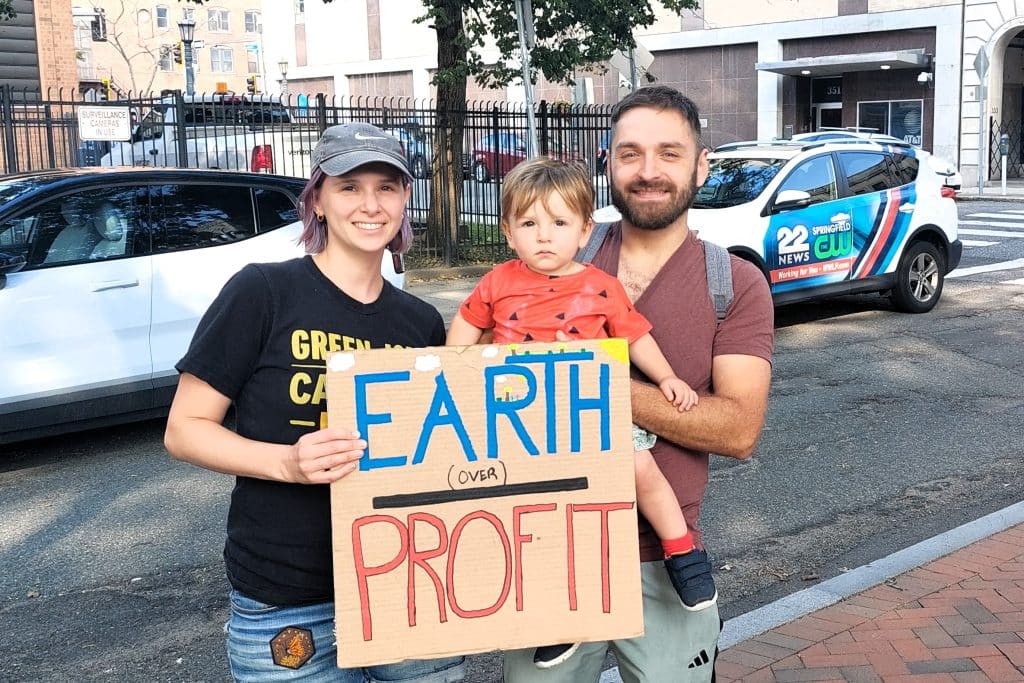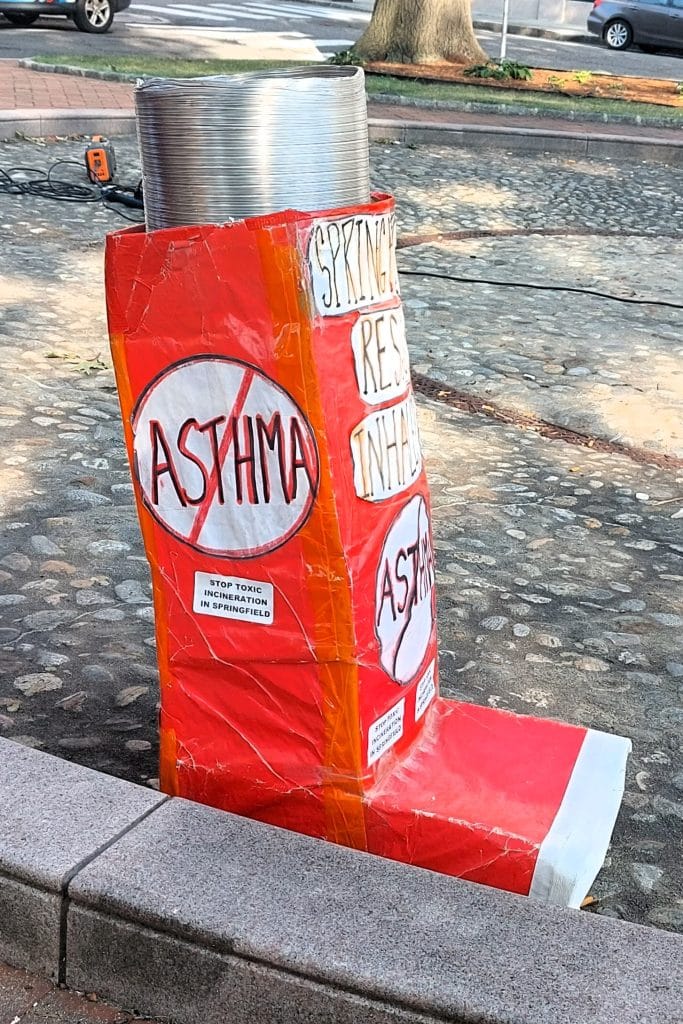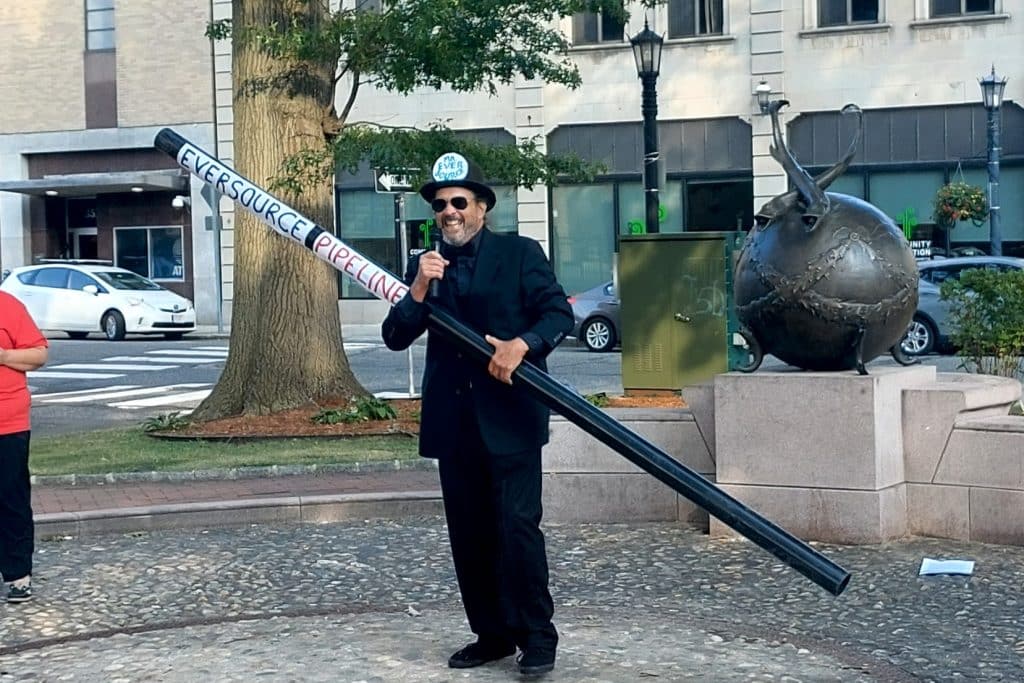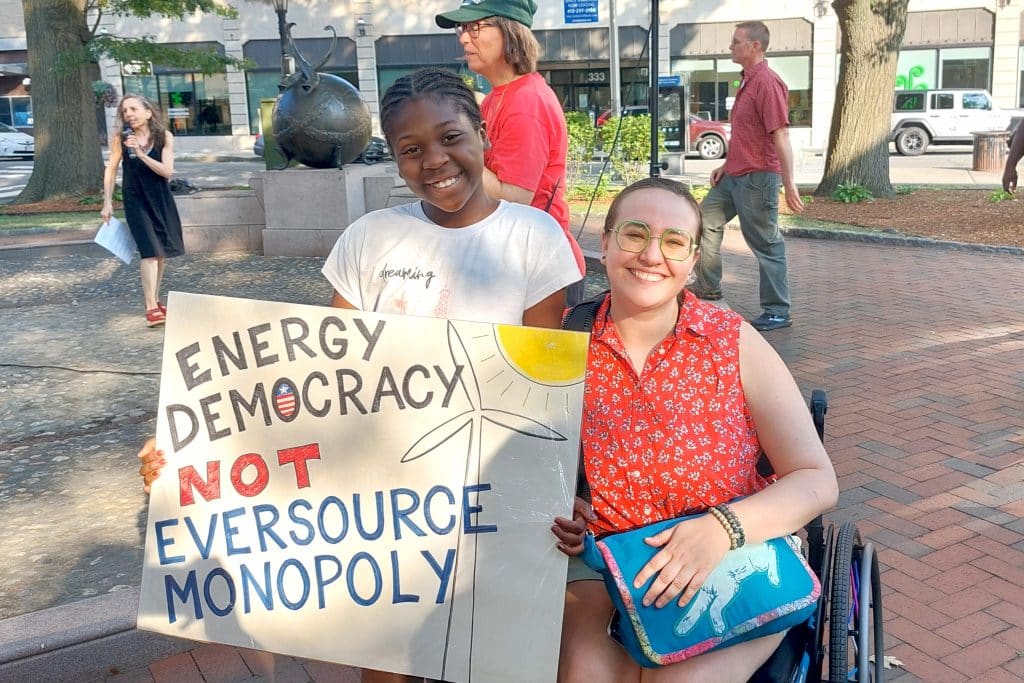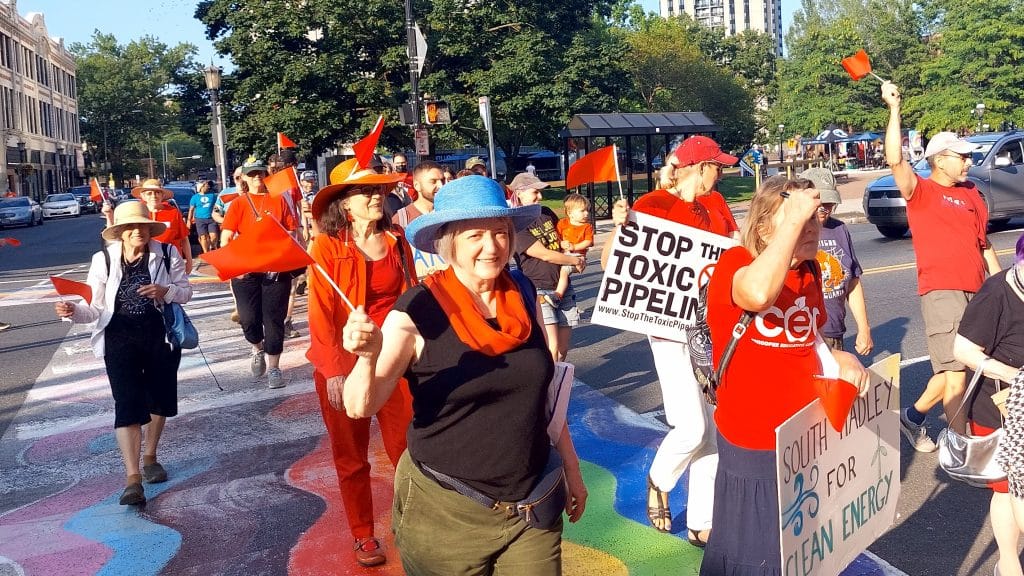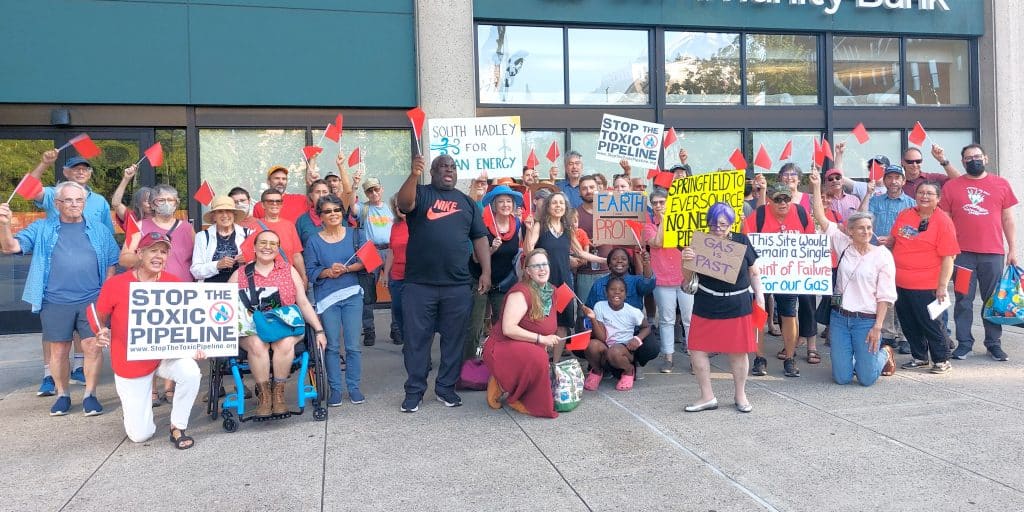Eversource’s Richard Salarezza shows Springfield resident Juan Latorre the potential routes for the pipeline.
Reminder Publishing photo by Sarah Heinonen
SPRINGFIELD — It was standing room only at the UMass Henry M. Thomas Center at Tower Square in Springfield as city residents, those from neighboring Longmeadow and other communities listened to Eversource representatives present their plans to build a natural gas pipeline.
The Western Massachusetts Natural Gas Reliability Project would build a metering station on the Connecticut border in Longmeadow, where Tennessee Gas already has a pipeline.
Connecting to that infrastructure, Eversource would run a new pipeline through Longmeadow, north into Springfield and connect it to the Bliss Street station on the bank of the Connecticut River.
The project, which would offer a second route to deliver natural gas to 52,000 metered customers in the lower Pioneer Valley, was first proposed by Columbia Gas in 2017. Soon after, Eversource purchased the other company’s infrastructure in the area. In 2021, Eversource again proposed the project.
Just as Columbia had experienced, residents in both Longmeadow and Springfield have pushed back against the project, citing concerns about the safety of natural gas pipelines, the impact on the environment and the cost of the project, which will eventually be paid through customers’ bills.
In 2023, the Massachusetts Environmental Policy Act Office told Eversource that it needed to fully vet alternatives to the proposed project before it could move forward. Now, the company is once again seeking approval from the Massachusetts Environmental Policy Act Office and the state’s Energy Facilities Siting Board.
The listening session began with a presentation by Eversource Project Manager Ryan Barnes. He explained that natural gas customers in Agawam and West Springfield, and substantial portions of Southwick, Chicopee and Springfield, receive their gas through a pipeline that connects to a Tennessee Gas line in Agawam and runs under Memorial Bridge to the Bliss Street station.
Barnes said that using a single route to deliver the gas leaves the system vulnerable to outages in the case of a natural disaster of severe weather event. Unlike electricity, he said, natural gas outages can last weeks or even months. By building a new pipeline through Longmeadow and Springfield, the gas can be split between the lines or, if one becomes damaged, the other pipeline can carry the full load until repairs can be made.
Barnes emphasized several times throughout the meeting that the pipeline will not serve any new customers and is only meant to lessen the load for the existing pipeline and serve as a backup should that one fail.
Eversource considered alternatives to the project, including electrification and geothermal options, but Barnes said these would have been more costly to ratepayers. The company also looked at providing liquified or compressed natural gas, as opposed to the natural gas liquids it delivers. Finally, Barnes said, Eversource considered several routes, building an alternative point of delivery and expanding East Longmeadow’s point of delivery. He said these options either did not meet customer needs, were too impactful to the environment or were too costly.
Among the alternative routes for the pipeline, Barnes said Eversource considered running the line along the railroad tracks or through the conservation area east of the Connecticut River. While both of these took the pipeline out of residential areas, he said they were not chosen as a preferred route due to their impact on the environment and wildlife.
Instead, the preferred route runs from the point of delivery station on the grounds of the Longmeadow Country Club, up Shaker Road and Laurel Street, before cutting across Converse Street. It then follows Route 5 north to Longhill Street and ends at the station near Riverfront Park. This 5.3-mile route would impact roughly 1,000 abutters. Proposed alternatives to this would connect to Route 5 at Williams Street or follow Converse Street east to Dickinson Street before heading west again at The X in Springfield’s Forest Park neighborhood.
Barnes said the point of delivery station in Longmeadow would consist of six buildings, two run by Tennessee Gas and four run by Eversource. He assured the crowd that the exterior of the station buildings would match the country club’s existing architecture. Inside, the equipment would be monitored by Eversource 24 hours a day and personnel would be notified immediately if there were a leak. He said the station would be patrolled by Eversource technicians and alerted by DigSafe if work was being done in the area.
Barnes said if the Massachusetts Environmental Policy Act Office and Energy Facilities Siting Board approve the project, it would still need to go through local, state and federal permitting processes.
Questions
During the question-and-answer period, area resident Cathy Kristofferson said the Longmeadow Select Board and the Springfield City Council have both voted in opposition to the pipeline. There have also been active community groups protesting the project, including a rally in Stearns Square an hour before the forum. She asked why Eversource was forcing the pipeline on communities that have rejected it. Barnes reiterated the need for redundancy.
Longmeadow Select Board Chair Josh Levine asked about the cost of the project, both to the communities and to ratepayers. He said heating bills are already “astronomical.” Similarly, Springfield resident Steve Jones said the project was estimated at $40 million in 2017 and $65 million in 2022. Barnes said the price tag is now expected to be $85 million and attributed the increase to recent inflation rates. He said the project will add $1.25 per month to the average bill, a 1% increase. Another person in the audience said that the total cost would be about $1,600 per customer if split between 52,000 meters in the coverage area, but Barnes disputed that.
Springfield City Councilor Victor Davila, who represents the Forest Park neighborhood, wanted an assurance that the pipeline would not travel through the park. Barnes said the preferred route does not, but the state would have the final say on which route would be approved. A Longmeadow resident asked if the pipeline would run through people’s front yards. Barnes said the infrastructure would only be constructed under public roads, but did not exclude the possibility that it might disrupt the tree belt.
On the topic of the pipeline route, Longmeadow resident Curt Freedman asked why a second pipeline cannot be run parallel to the existing one under Memorial Bridge. Another option would be to run it under the conservation area close to the Connecticut River in Longmeadow, which would take it out of residential neighborhoods. Eversource’s Jeff Brant said there would be “a lot more impacts” to wildlife and the wetlands. Freedman retorted, “How about the prioritization of humans as opposed to turtles and fish.”
A Springfield resident said his home was affected in 2012, when a leak from a low-pressure gas line caused an explosion on Worthington Street, which injured 17 people. He asked if there were existing gas leaks in Springfield, which Barnes confirmed. “Fix those first,” the resident said. At several points during the forum, the crowd chanted “Fix the leaks.”
Springfield resident Juan Latorre said Springfield has more miles of leak-prone gas lines than any other community. He asked what investment the company is making in addressing that. Barnes assured him that the company is replacing leaking gas lines while also pursuing the new pipeline.
Echoing those concerns, Springfield’s Naia Tenerowicz said the pipeline would run within 500 feet of Sumner Avenue School. It would also be within a mile of Wolf Swamp Road School in Longmeadow and Springfield’s South End Middle School.
Tenerowicz then asked why Eversource has not focused on securing the Bliss Street station. She said a train derailment or car accident could penetrate the “flimsy” fence around the structure, creating a “single point of failure” not helped by a secondary pipeline. Barnes said Eversource is actively replacing the station and moving the equipment underground for safety.
Tenerowicz also asked why there was a push to mitigate the risk to the Memorial Bridge pipeline, when it had not created an outage in 70 years. Barnes said Eversource was concerned with a potential disruption anywhere along the 7.4-mile Agawam-based pipeline, not just the section under Memorial Bridge. He also said the utility must prepare for the future rather than speak to the past.
Many residents made comments about continued investments in fossil fuels, despite the state’s climate goals. Again, Barnes emphasized that the pipeline would serve no additional gas customers, meaning there would be no additional impact on the climate.
Springfield resident Teniel Rhiney said Springfield is the only community in the state with an active gas pipeline project. Meanwhile, the eastern part of the state is seeing investments in electrification. She said, “Those who can afford it” are being delivered clean energy, while Springfield was being left with “dirty” fossil fuels, despite being fourth in the nation for asthma rates. Barnes acknowledged that Springfield is an environmental justice community, but he reemphasized that there was an “unacceptable” risk of an outage.
Comments on the pipeline can be submitted to Eversource at ProjectInfoMA@eversource.com. People can also submit comments to the Massachusetts Environmental Protection Act Office at MEPA@mass.gov.
Protest
Before the forum, about 50 people rallied at Stearns Square in Springfield on Aug. 7 to oppose the project.
People wielding signs and red flags watched a piece of street theater in which a man dressed as “Mr. Eversource” cradled a “pipeline” as residents railed against what they saw as the environmental and safety risks of the project.

